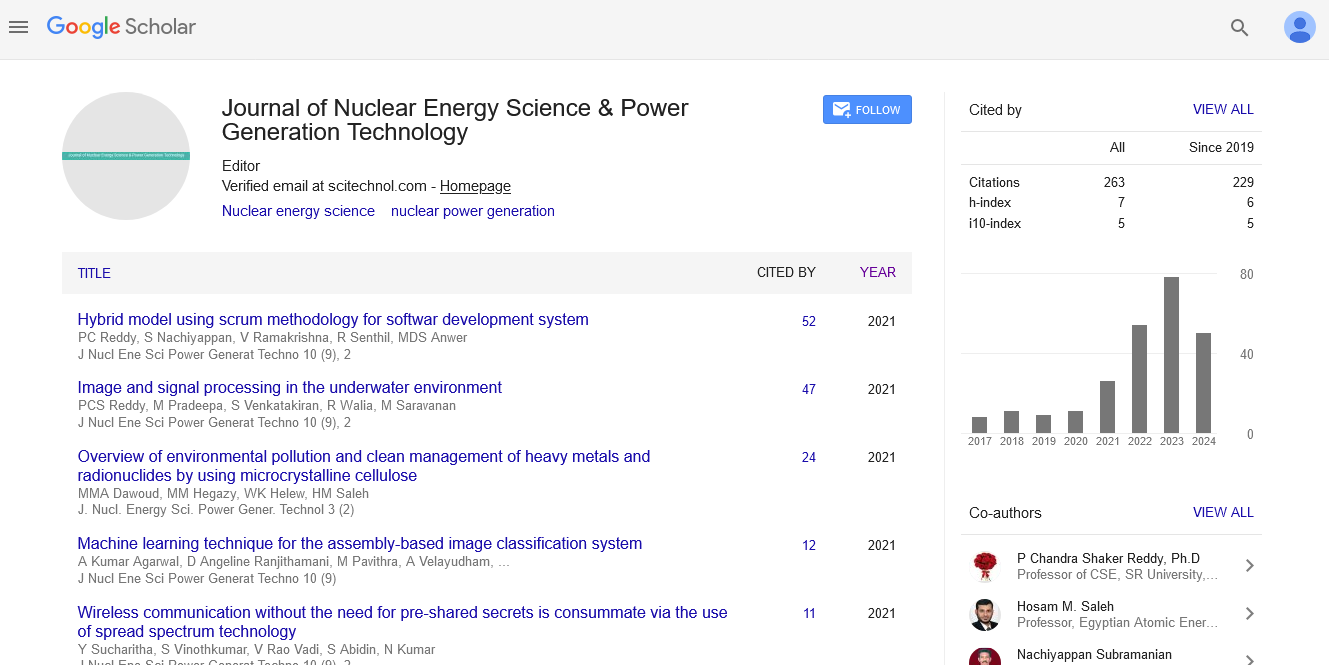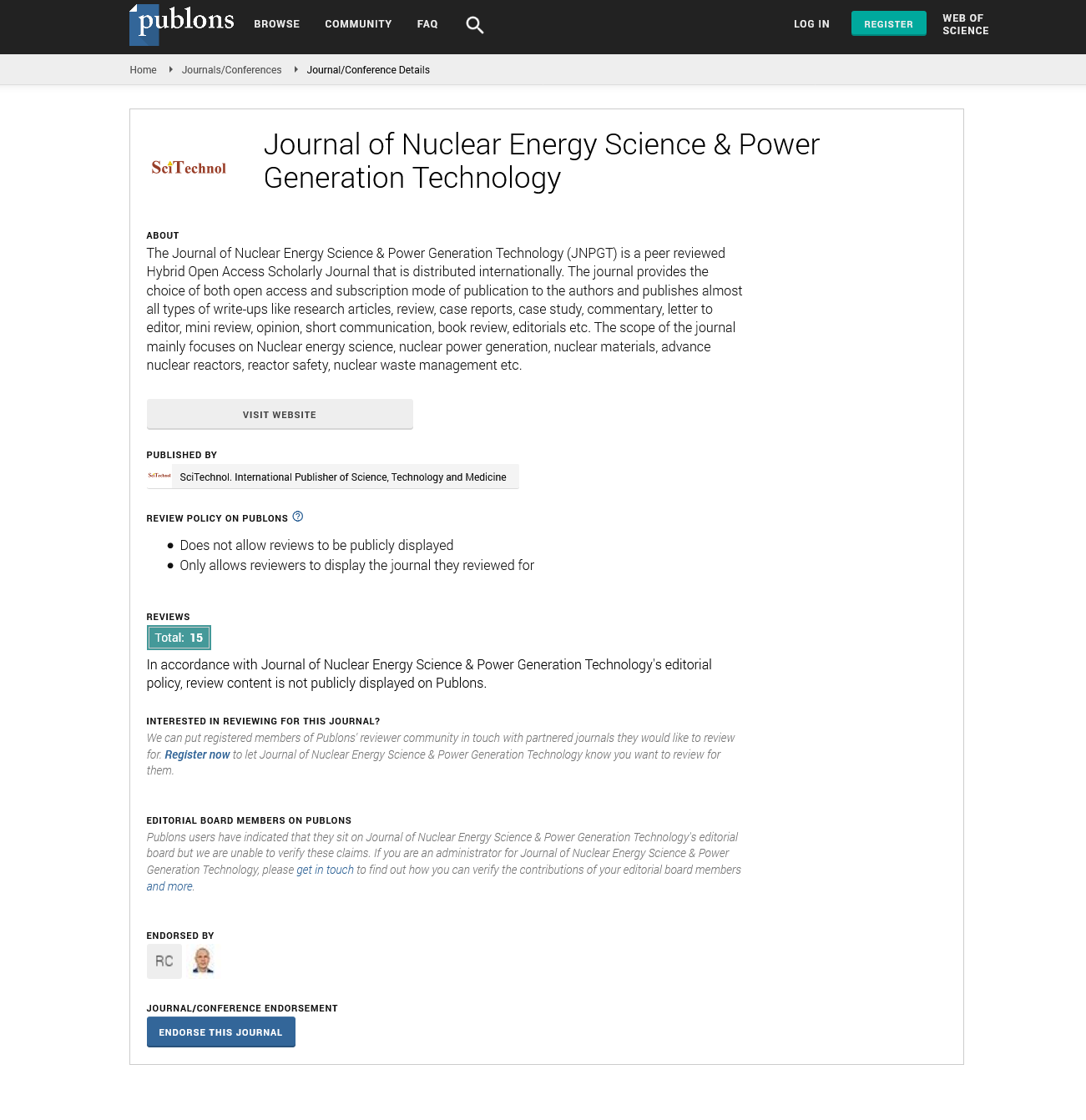Opinion Article, J Nucl Ene Sci Power Generat Technol Vol: 13 Issue: 3
Heat Transfer Mechanisms and Optimization in Nuclear Thermal-Hydraulics
Trsndi Jina*
1Department of Nuclear Engineering and Radiation Science, Missouri University of Science and Technology, Rolla, USA
*Corresponding Author: Trsndi Jina,
Department of Nuclear Engineering and
Radiation Science, Missouri University of Science and Technology, Rolla, USA
E-mail: tsndi_jina190@gmail.com
Received date: 26 April, 2024, Manuscript No. JNPGT-24-140228;
Editor assigned date: 29 April, 2024, PreQC No. JNPGT-24-140228 (PQ);
Reviewed date: 14 May, 2024, QC No. JNPGT-24-140228;
Revised date: 21 May, 2024, Manuscript No. JNPGT-24-140228 (R);
Published date: 29 May, 2024, DOI: 10.4172/2325-9809.1000394.
Citation: Jina T (2024) Heat Transfer Mechanisms and Optimization in Nuclear Thermal-Hydraulics. J Nucl Ene Sci Power Generat Technol 13:3.
Description
Thermal-hydraulics is an important field within nuclear engineering that focuses on the behavior of heat and fluids within a nuclear reactor. This interdisciplinary study combines principles of thermodynamics, heat transfer, and fluid mechanics to ensure the safe and efficient operation of nuclear power plants. Effective thermal-hydraulic management is vital for maintaining reactor stability, optimizing performance, and preventing accidents. At its core, thermal-hydraulics examines how heat generated in a nuclear reactor core is removed and transported by the coolant, typically water, to generate steam and drive turbines for electricity production. Understanding the modes of heat transfer (conduction, convection, and radiation) is essential. In a reactor, conduction occurs within fuel rods, convection in the coolant, and radiation primarily in the reactor core. This involves studying the flow behavior of the coolant as it absorbs heat from the reactor core and transports it to the steam generators. Fluid dynamics principles help predict pressure drops, flow rates, and turbulence, which are vital for reactor safety and efficiency. Thermodynamic principles govern the energy exchanges within the reactor system, from the nuclear reactions in the core to the work done by the turbines.
Thermal-hydraulic challenges in nuclear reactors
Efficient removal of heat from the reactor core is vital to prevent overheating and potential meltdown. This requires a deep understanding of heat transfer rates and the capacity of the coolant.
Ensuring a consistent and adequate flow of coolant is essential. Any disruptions can lead to localized overheating or "hot spots," which can damage reactor components. Maintaining appropriate pressure levels within the reactor coolant system prevents phase changes (e.g., from liquid to steam) that can impair heat transfer efficiency and reactor stability managing the complex behavior of coolant as it transitions between liquid and vapor phases, especially in Boiling Water Reactors (BWRs), significant analytical and operational challenges.
Advanced thermal-hydraulic analysis and simulation
CFD simulations provide detailed insights into fluid flow and heat transfer processes within the reactor. These models help predict temperature distributions, flow patterns, and potential areas of concern. These tools are essential for safety analysis and regulatory compliance. Combining thermal-hydraulic models with other physical phenomena, such as structural mechanics and neutron kinetics, enables a more comprehensive understanding of reactor behavior under various conditions.
Applications and implications
Thermal-hydraulic principles guide the design of reactor cores, coolant systems, and safety features. Efficient designs ensure optimal heat removal and minimize risks. Thermal-hydraulic models are integral to assessing reactor safety under normal and accident conditions. Scenarios such as loss-of-coolant accidents or transient overpower conditions are rigorously analyzed to ensure robust safety margins.
Conclusion
Thermal-hydraulics is a foundational aspect of nuclear engineering that ensures the safe and efficient operation of nuclear reactors. By integrating principles of heat transfer, fluid dynamics, and thermodynamics, thermal-hydraulic engineers address the complex challenges of heat removal, coolant flow, and pressure management. Advances in computational tools and modeling techniques continue to enhance our understanding and capability, making nuclear power a safer and more reliable energy source. As the nuclear industry evolves, thermal-hydraulics will remain a vital field, driving innovation and maintaining rigorous safety standards. By understanding and optimizing thermal-hydraulic processes, engineers can enhance reactor efficiency, leading to increased power output and reduced operational costs. Compliance with nuclear safety regulations often requires extensive thermal-hydraulic analysis to demonstrate that reactors can operate safely under prescribed conditions.
 Spanish
Spanish  Chinese
Chinese  Russian
Russian  German
German  French
French  Japanese
Japanese  Portuguese
Portuguese  Hindi
Hindi 

